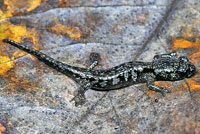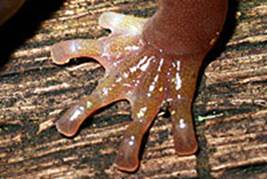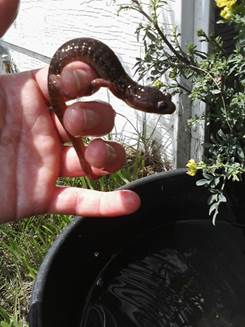This has no digestive organs, and gets no food but from the fire, in which it constantly renews its scaly skin. The salamander, which renews its scaly skin in the fire,—for virtue —Leonardo da Vinci
This is a common California salamander with a wide distribution that extends along the coast from Baja California through southern CA to Humboldt County and into the Sierra foothills. It is especially common in the San Francisco Bay area and can be found in shaded garden beds, walking around in the evening, or climbing on walls and trees after a rain in November or in the spring. These salamanders are brown with cream-colored spots that vary in size – an individual may have a number of spots or none. Young salamanders are dark with patches or flecks of light and their limbs have no yellow or orange coloring – which makes them distinct from some other similar species.

Males exhibit a particularly large and triangle shaped head. Adults are about 7 inches in total length, making them the largest species of the genus Aneides. The tail is prehensile, meaning that they can grasp with it, and the toe tips are wide and square to facilitate climbing. Its common name – arboreal – means tree climber.

This salamander has 15 coastal grooves along the side and two nasiolabial grooves leading from their nostril to the upper lip, which is lined with glands for chemoreception. And yes – be careful because of their teeth!

Aneides – Greek for lacking form or shape, and lugubris, Latin for gloomy/dark – possibly referring to the coloration(?).
They may squeak when picked up. According to Stebbins and Cohen, (1997) an Arboreal Salamander “…may squeak repeatedly when caught, retracting its eyes into their sockets each time a sound is produced, When the eyeballs are depressed, their undersides protrude into the mouth cavity, thereby compressing the air in the mouth and forcing it outward. It is this movement that appears somehow to cause the sounds produced.”
Arboreal salamanders are members of the family Plethodontidae – the lungless salamanders. Plethodontid salamanders do not breathe through lungs but rather respire through their skin and mouth tissues, thus limiting them to damp environments. They can only move about above ground on high humidity days. Arboreal salamanders eat quite a variety of invertebrates including millipedes, centipedes, moths, sowbugs, ants, and termites among others.
They have been known to prey on smaller salamanders using their sit-and-wait approach. Prey is captured with the tongue and drawn into the mouth where it is crushed. Reproduction occurs on land. The male has a gland beneath its chin that he uses to deliver pheromones by quickly stroking it along the female’s back during courtship while scratching her skin with his teeth. What could be more romantic than that? During courtship, many Plethodontid females will follow a pheromone track laid down by the male and then pick up a sperm packet dropped by the male as they pass over it – initiating fertilization.
Females lay 5-25 eggs during the spring in moist, decaying cavities of oak trees (often high above the ground), under rocks or other substrate, and inside logs. The female will stay with the eggs until they hatch, often coiling her body around the clutch. Multiple salamanders may cooperate and lay their eggs in the same place. The young develop in the egg and hatch as fully formed salamanders – as opposed to some salamanders that have an aquatic phase and are born with gills, which they lose when the morph into terrestrial forms.
Salamanders in general pop up in folklore and were thought to have the ability to put out fire or at least resist it – possibly from crawling out from logs placed on the fire. This is why it often shows up as a symbol on fire-fighter emblems and as a prominent metaphor in Ray Bradbury’s novel Fahrenheit 451.

My daughter, Chloe sent me this photo from the Bay Area when she found an arboreal salamander in her garden in the spring and inquired on the species. She kept me up to date on where she would find them – next to the wood of raised beds, under flower pots, under paving stones, etc. They are quite lively and so far we’ve both managed to avoid being nipped by them.

